|
|
|
Sort Order |
|
|
|
Items / Page
|
|
|
|
|
|
|
| Srl | Item |
| 1 |
ID:
103527
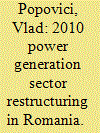

|
|
|
|
|
| Publication |
2011.
|
| Summary/Abstract |
In the spring of 2009, the Romanian government has proposed a restructuring of the national power generation sector segment that is still owned by the state. As most of the power generation capacity is still state-owned, this restructuring will dramatically alter the competitive landscape of this sector. This paper is analyzing the rationale and principles of the restructuring as stated by government documents and officials, the assessment methodology and criteria proposed by the government, as well as the proposed final outcome of the restructuring initiative. Based on this critical assessment and the early results of the restructuring's implementation, we are able to make recommendations that can be considered for a revised restructuring approach.
|
|
|
|
|
|
|
|
|
|
|
|
|
|
|
|
| 2 |
ID:
103393


|
|
|
|
|
| Publication |
2011.
|
| Summary/Abstract |
It is imperative to tackle the issue globally mobilizing all available policies and measures. One of the important ones among them is technology transfer and diffusion. By utilizing international co-operation, industry can promote such measures in two ways: through government policy and through industry's own voluntary initiative. Needless to say, various government policies and measures play essential role. By the same token, industry initiative can complement them. There is much literature documenting the former. On the contrary there are few on the latter. This paper sheds light on the latter. The purpose of this paper is to explore the effectiveness of global voluntary sectoral approach for technology diffusion and transfer based on steel sector experience.
The goal is to contribute toward building a worldwide low-carbon society by manufacturing goods with less energy through international cooperation of each sector. The authors believe that the voluntary sectoral approach is an effective method with political and practical feasibilities, and hope to see the continued growth of more initiatives based on this approach.
|
|
|
|
|
|
|
|
|
|
|
|
|
|
|
|
| 3 |
ID:
103463


|
|
|
|
|
| Publication |
2011.
|
| Summary/Abstract |
Wind energy deployment varies widely across regions and this variation cannot be explained by differences in natural wind resources alone. Evidence suggests that institutional factors beyond physical wind resources can influence the deployment of wind energy systems. Building on the work of Toke et al. (2008), this study takes a historical institutionalist approach to examine the main factors influencing wind energy deployment across four Canadian provinces Canada: Alberta, Manitoba, Ontario and Nova Scotia. Our case studies suggest that wind energy deployment depends upon a combination of indirect causal factors-landscape values, political and social movements, government electricity policy, provincial electricity market structure and incumbent generation technologies and direct causal factors-grid architecture, ownership patterns, renewable incentive programs, planning and approvals processes and stakeholder support and opposition.
|
|
|
|
|
|
|
|
|
|
|
|
|
|
|
|
| 4 |
ID:
103404
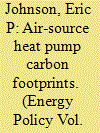

|
|
|
|
|
| Publication |
2011.
|
| Summary/Abstract |
European governments see that heat pumps could reduce carbon emissions in space- and hot-water heating. EU's Renewable Energy Directive designates heat pumps as renewable - eligible for various subsidies - if their carbon footprints are below an implied, average threshold. This threshold omits carbon generated by manufacture and emission of a heat-pump's fluorocarbon refrigerant. It also omits the footprint of the heat pump's hardware. To see if these omissions are significant, this study calculated carbon footprints of representative, residential heat pumps in the UK.
Three findings emerged. First, in relation to power generation, which accounts for most of a heat-pump's greenhouse-gas emissions, fluorocarbons add another 20% to the footprint. Second, at UK efficiencies a heat-pump footprint (in kg CO2e emitted per kWh delivered) is comparable or higher than footprints of gaseous fuels used in heating. It is lower than the footprint of heating oil and far lower than the footprints of solid fuels. Third, production and disposal of a heat pump's hardware is relatively insignificant, accounting for only 2-3% of the overall heat-pump footprint. Sensitivities to the results were assessed: key factors are footprint of electricity generation, F-gas composition and leak rates and type of wall construction.
|
|
|
|
|
|
|
|
|
|
|
|
|
|
|
|
| 5 |
ID:
103460


|
|
|
|
|
| Publication |
2011.
|
| Summary/Abstract |
China is the world's second-largest energy producer and consumer, so that it is very necessary to analyze China's energy situation for saving energy consumption and reducing GHG emission. Energy flow chart is taken as a useful tool for sorting out and displaying energy statistics data. Energy statistics data is the premise and foundation for analyzing energy situation. However, there exit many differences between China and foreign energy balance. Based on the international criterion of energy balance and some advices given by related experts, the author properly adjusts China's energy balance. And the purpose of this paper is to draft China's energy flow chart for 2007, which is used to study the characteristics of energy production and consumption in China. We find that: (1) coal is the main energy in China, which accounted for 73.2% of total energy supply in 2007; (2) thermal power accounted for 83.2% of the total electricity supply, and 78.43% thermal power was based on coal; (3) in 2007, the secondary industrial sector consumed about 69.93% of energy; (4) China's energy utilization efficiency was about 33.23% in 2007.
|
|
|
|
|
|
|
|
|
|
|
|
|
|
|
|
| 6 |
ID:
103440


|
|
|
|
|
| Publication |
2011.
|
| Summary/Abstract |
In 2009 the EU decided to reduce greenhouse gas emissions at least by 20% in 2020 compared to 1990 and to supply 20% of energy needs by 2020 from renewable energy sources. This paper uses an energy model coupled with a non-CO2 greenhouse gas model to assess the range of policy options that were debated to meet both targets. Policy options include trading of renewable targets, carbon trading in power plants and industry and the use of the Clean Development Mechanism to improve cost-efficiency. The models also examined fairness by analysing the distribution of emission reduction in the non-emission trading sector, the distribution of CO2 allowances in the emission trading sector and the reallocation of renewable targets across Member States. The overall costs of meeting both targets range from 0.4% to 0.6% of GDP in 2020 for the EU as a whole. The redistribution mechanisms employed significantly improve fairness compared to a cost-effective solution.
|
|
|
|
|
|
|
|
|
|
|
|
|
|
|
|
| 7 |
ID:
103441
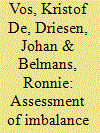

|
|
|
|
|
| Publication |
2011.
|
| Summary/Abstract |
This article deals with a specific support mechanism exempting offshore wind power generators partially from their balancing responsibilities by means of a tolerance margin. This specific support mechanism was enforced in Belgium as from 2009 and is defended by its proponents in view of the lower power output predictability at offshore locations. Although policies accommodating offshore developments may be seen as important to tap better wind resources, this contribution stresses the importance of full balancing responsibility for variable renewables. After a detailed evaluation of the support mechanism and its impact on the balancing costs for wind power generators, the use of current applied production support mechanisms is recommended. These can be used to acquire the same financial effect without increasing market complexity and harming the operation of the balancing market. The first part of the study deals with the specific implementation of the tolerance margin in the Belgian context. Secondly, its underlying motivation is quantitatively assessed, namely the relatively higher offshore prediction errors. Finally, the total offshore subsidy resulting from the measure is determined. Expressed in €/MWh, this subsidy is currently determined at €1.4-1.7/MWh, which represents the required increase of production support in order to replace the regulation.
|
|
|
|
|
|
|
|
|
|
|
|
|
|
|
|
| 8 |
ID:
103382


|
|
|
|
|
| Publication |
2011.
|
| Summary/Abstract |
European freight transport emissions and fuel consumption are projected to increase. This study focuses on long distance freight transport (LDFT) and explores possible sustainable futures through quantitative modeling. The evaluation was part of European foresight process between researchers, policy makers and freight companies (FREIGHTVISION). Greenhouse gas (GHG) emissions and energy demand of road, rail and inland waterways were estimated for an EU-27 in 2005. Development was extrapolated to 2050 based on technology and freight performance forecasts. Stakeholders found the forecasted GHG emissions and fossil fuel share unsustainable, so alternative futures were developed with backcasting. The developed emission model was run with random parameter combinations to screen a set of sustainable futures, with an 80% reduction of GHG emissions and fossil fuel share. Freight transport performance was not controlled in the backcasts, but several sustainable futures were found if significant changes in transport efficiency and energy mix are implemented. In spite of agreeing on the importance of reducing emissions, stakeholders had difficulties in choosing a preferred technological future. Simple models were found to be an effective tool for communicating the influence of various measures. Further research is recommended to screen preferable technological roadmaps from the broad range of available futures.
|
|
|
|
|
|
|
|
|
|
|
|
|
|
|
|
| 9 |
ID:
103370
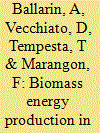

|
|
|
|
|
| Publication |
2011.
|
| Summary/Abstract |
Energy production from biomasses can be an important resource that, when combined with other green energies such as wind power and solar plants, can contribute to reduce dependency on fossil fuels. The aim of this study is to assess how agriculture could contribute to the production of bio-energy. A multi-period Weighted Goal Programming model (MpWGP) has been applied to identify the optimal land use combinations that simultaneously maximise farmers' income and biomass energy production under three concurrent constraints: water, labour and soil availability. Alternative scenarios are considered that take into account the effect of climate change and social change. The MpWGP model was tested with data from the Rovigo county area (Italy) over a 15-year time period.
Our findings show that trade-off exists between the two optimisation targets considered. Although the optimisation of the first target requires traditional agricultural crops, which are characterised by high revenue and a low production of biomass energy, the latter would be achievable with intensive wood production, namely, high-energy production and low income. Our results also show the importance of the constraints imposed, particularly water availability; water scarcity has an overall negative effect and specifically affects the level of energy production.
|
|
|
|
|
|
|
|
|
|
|
|
|
|
|
|
| 10 |
ID:
103388
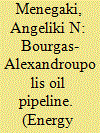

|
|
|
|
|
| Publication |
2011.
|
| Summary/Abstract |
This paper employs Muthoo's bargaining principles/prerequisites for an effective bargaining result (Muthoo (2000). A Non-Technical Introduction to Bargaining Theory, World Economics 1(2): 145-166) to decide whether Greece and Bulgaria can form a successful energy coalition. Motivation for this is the proposed construction of the crude oil pipeline from the Bulgarian port Burgas to the Greek Aegean port of Alexandroupolis. The reason Turkey is the third country in the analysis despite its current non-membership in this venture, is that: (i) Turkey offers to host a competitive route of the pipeline, (ii) It is a transit, neighboring country to Greece forming an important geopolitical triangle together with Greece and Bulgaria and (iii) co-operates separately with Bulgaria and Greece in other energy pipelines. Therefore, the three countries engage to interwining energy and geopolitical futures. Whether B-A oil pipeline will be implemented or not, will be due to a mix of bargaining procedures. The paper shows that Muthoo's principles/prerequisites for an effective bargaining result, through their constituents (selected economy and energy figures and characteristics), are fulfilled by Greece and Bulgaria. A broader coalition with the inclusion of Turkey might also be permissible and promising based on this theory.
|
|
|
|
|
|
|
|
|
|
|
|
|
|
|
|
| 11 |
ID:
103458
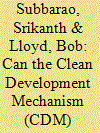

|
|
|
|
|
| Publication |
2011.
|
| Summary/Abstract |
The paper investigates whether the Clean Development Mechanism (CDM) under the Kyoto Protocol has played a significant role in the development of rural communities, specifically investigating uptake of small-scale renewable energy projects. The investigation involved an assessment of 500 registered small-scale CDM projects under the Kyoto Protocol in terms of their potential impact on the envisaged sustainable development goals for rural communities. Five case studies from the Indian subcontinent were also examined.
The paper concludes that the CDM in its current state and design has typically failed to deliver the promised benefits with regard to development objectives in rural areas. Successful projects were found to have had good community involvement and such projects were typically managed by cooperative ventures rather than money making corporations. The paper puts forward a new framework for the assessment of such benefits in the hope that future projects can be better assessed in this regard. The key problem, however, remains on how to deal with the inherent contradiction between development and sustainability.
|
|
|
|
|
|
|
|
|
|
|
|
|
|
|
|
| 12 |
ID:
103401


|
|
|
|
|
| Publication |
2011.
|
| Summary/Abstract |
Denmark's future energy system is to be entirely based on renewable energy sources. Municipalities will play an important role as local energy planning authorities in terms of adopting and refining this vision in different local contexts. Based on a review of 11 municipal energy plans, this paper examines to what extent municipal energy planning matches national 100% renewable energy strategies. The results indicate a willingness among Danish municipalities to actively carry out energy planning, and the plans reveal a large diversity of (new) activities. At the same time, however, there is a strong need for better coordination of municipal energy planning activities at the central level. It is suggested that the role of municipalities as energy planning authorities needs to be outlined more clearly in, e.g., strategic energy planning which integrates savings, efficiency and renewable energy in all (energy) sectors. This requires the state to provide municipalities with the necessary planning instruments and establish a corresponding planning framework. Consequently, there is a need for a simultaneous centralisation and decentralisation during the implementation of the 100% renewable energy vision. The paper outlines a basic division of tasks between the central and the local level within such a strategic energy planning system.
|
|
|
|
|
|
|
|
|
|
|
|
|
|
|
|
| 13 |
ID:
103402


|
|
|
|
|
| Publication |
2011.
|
| Summary/Abstract |
In 2007, the Government of Canada announced its medium- and long-term greenhouse gas (GHG) emissions reduction plan entitled Turning the Corner, proposed emission cuts of 20% below 2006 levels by 2020 and 60-70% below 2006 levels by 2050. A report from a Canadian government advisory organization, the National Round Table on Environment and Economy (NRTEE), Achieving 2050: A carbon pricing policy for Canada, recommended "fast and deep" energy pathways to emissions reduction through large-scale electrification of Canada's economy by relying on a major expansion of hydroelectricity, adoption of carbon capture and storage for coal and natural gas, and increasing the use of nuclear.
This paper examines the likelihood of the pathways being met by considering the report's proposed energy systems, their associated energy sources, and the magnitude of the changes. It shows that the pathways assume some combination of technological advances, access to secure energy supplies, or rapid installation in order to meet both the 2020 and 2050 targets. This analysis suggests that NRTEE's projections are optimistic and unlikely to be achieved.
The analysis described in this paper can be applied to other countries to better understand and develop strategies that can help reduce global greenhouse gas emissions.
|
|
|
|
|
|
|
|
|
|
|
|
|
|
|
|
| 14 |
ID:
103399


|
|
|
|
|
| Publication |
2011.
|
| Summary/Abstract |
China, now the world's second-largest economy, is worried about energy security, which underpins the core objectives of Beijing and the political legitimacy of the Communist Party of China. The purpose of this study is to explore certain popular myths about China's energy security. The study consists of six parts. After the introduction, it formulates the obscure concept of "energy security" and attempts to contextualize it with "Chinese characteristics." Then it explicitly points out that the largest driver of oil demand by China as the "World's Factory" is transport instead of industry. Next, it explores the effectiveness of transnational pipelines as a measure of energy security and explains why they are less effective than many observers have previously assumed. Furthermore, it investigates the global expansion of Chinese national oil companies and questions their actual contribution to energy security. A few concluding remarks then follow.
|
|
|
|
|
|
|
|
|
|
|
|
|
|
|
|
| 15 |
ID:
103381


|
|
|
|
|
| Publication |
2011.
|
| Summary/Abstract |
The paper attempts to test the Environment Kuznets Curve (EKC) hypothesis for 36 high-income countries for the period 1980-2005. The test is based on the suggestion of Narayan and Narayan (2010). Various panel data unit root and co-integration tests are applied. Carbon dioxide (CO2) emissions and GDP series are integrated of order one and co-integrated, especially after controlling for cross-sectional dependence. Additionally, the Blundell-Bond system generalised methods of moments (GMM) is employed to conduct a panel causality test in a vector error-correction mechanism (VECM) setting. Unidirectional causality running from real per capita GDP to per capita CO2 emissions is uncovered in both the short-run and the long-run. The empirical analysis based on individual countries provides evidence of an EKC for Greece, Malta, Oman, Portugal and the United Kingdom. However, it can be observed that for the whole panel, a 1% increase in GDP generates an increase of 0.68% in CO2 emissions in the short-run and 0.22% in the long-run. The lower long-run income elasticity does not provide evidence of an EKC, but does indicate that, over time, CO2 emissions are stabilising in the rich countries.
|
|
|
|
|
|
|
|
|
|
|
|
|
|
|
|
| 16 |
ID:
103465
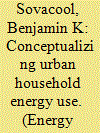

|
|
|
|
|
| Publication |
2011.
|
| Summary/Abstract |
This article begins by defining energy services and identifying how they differ according to sector, urban and rural areas, and direct and indirect uses. It then investigates household energy services divided into three classes: lower income, middle income, and upper income. It finds that the primary energy technologies involved with low-income households involve a greater number of fuels and carriers, ranging from dung and fuelwood to liquefied petroleum gas and charcoal, but a fewer number of services. Middle-income households throughout the world tend to rely on electricity and natural gas, followed by coal, liquefied petroleum gas, and kerosene. These homes utilize energy to produce a much broader range services. The upper class or rich have access to the same energy fuels, carriers, and technologies as middle-income homes and families, but consume more energy (and more high luxury items). The study highlights how focusing on energy services reorients the direction of energy policy interventions, that energy services are neither uniform nor innate, and by noting exciting areas of potential research.
|
|
|
|
|
|
|
|
|
|
|
|
|
|
|
|
| 17 |
ID:
103391
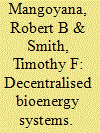

|
|
|
|
|
| Publication |
2011.
|
| Summary/Abstract |
Decentralised bioenergy systems are receiving increasing attention due to the potential ability to support local development, create local employment, and contribute to climate change mitigation. These issues, along with other bioenergy sustainability issues, are reviewed through eighteen international case studies with the objective of identifying opportunities and threats to decentralised bioenergy systems. The case studies were selected based on feedstock type, bioenergy type, production capacity, synergistic alliances, ownership structure and physical locations. This variation was used to provide a basis for evaluating opportunities and threats from different contexts. Commercial viability remains the primary concern for the sustainability of decentralised bioenergy systems. There are, however, opportunities for compounding benefits through integrating small scale decentralised bioenergy systems with other production systems. Integrated production, including closed loop models, allow waste materials from one process to be used as inputs in other production processes, and thereby increasing economic, social and environmental outcomes. Synergistic opportunities along the bioenergy production chain, which include feedstock production, bioenergy marketing and distribution could also be exploited by communities and other investors to minimise decentralised production risk.
|
|
|
|
|
|
|
|
|
|
|
|
|
|
|
|
| 18 |
ID:
103488


|
|
|
|
|
| Publication |
2011.
|
| Summary/Abstract |
Energy intensity of the total primary energy supply (TPES), total final energy consumption (TFC) and LOSSES in the conversion from TPES to TFC were analyzed for the World, OECD and Rest of the World (ROW) countries. LOSSES increased significantly for all groups of countries due to the increase of electricity production from coal in the period studied (1971-2008). Electricity share final consumption almost doubled, increasing from 8.8% to 17.2% in the period studied. However the energy intensity of LOSSES remained practically constant, which reflects the fact that the efficiency of electricity generation from coal (the main source of electricity) remained practically constant in that period. Despite the attractiveness of end-use devices running on electricity such as computers, which is typical of modern societies, the CO2 emissions are bound to increase unless coal is replaced by less carbon emitting sources such as natural gas, renewables and nuclear energy.
|
|
|
|
|
|
|
|
|
|
|
|
|
|
|
|
| 19 |
ID:
103443


|
|
|
|
|
| Publication |
2011.
|
| Summary/Abstract |
This study evaluates the changes in CO2 emissions from energy consumption in Brazil for the period 1970-2009. Emissions are decomposed into production and consumption activities allowing computing the full set of energy sources consumed in the country. This study aims to develop a comprehensive and updated picture of the underlying determinants of emissions change from energy consumption in Brazil along the last four decades, including for the first time the recently released data for 2009. Results demonstrate that economic activity and demographic pressure are the leading forces explaining emission increase. On the other hand, carbon intensity reductions and diversification of energy mix towards cleaner sources are the main factors contributing to emission mitigation, which are also the driving factors responsible for the observed decoupling between CO2 emissions and economic growth after 2004. The cyclical patterns of energy intensity and economy structure are associated to both increments and mitigation on total emission change depending on the interval. The evidences demonstrate that Brazilian efforts to reduce emissions are concentrated on energy mix diversification and carbon intensity control while technology intensive alternatives like energy intensity has not demonstrated relevant progress. Residential sector displays a marginal weight in the total emission change.
|
|
|
|
|
|
|
|
|
|
|
|
|
|
|
|
| 20 |
ID:
103486


|
|
|
|
|
| Publication |
2011.
|
| Summary/Abstract |
Alternative fuels for the transport sector are gaining growing attention as a means against fossil fuel dependence and towards greener forms of energy. At the same time, however, they are surrounded with doubts concerning sustainability of their production. This work presents the basic framework for a decision support tool to evaluate biofuel production pathways, with the purpose of providing the decision maker with a structured methodology that will lead him to the final decision. The tool integrates the most important aspects along the entire value chain (i.e. from biomass production to biofuel end-use), namely the technical, economic, environmental and social aspect. The tool consists of a computational part, which can be combined with the personal preferences of the user. The analysis provides a score for the respective pathway that can be used to rank different options and select among them the optimal solution. The functionality of the tool has been tested for the case of biodiesel from rapeseed in Germany.
|
|
|
|
|
|
|
|
|
|
|
|
|
|
|
|
|
|
|
|
|